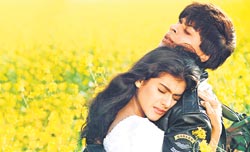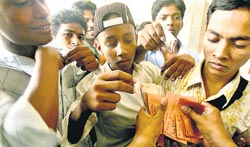
One movie, one theatre, 12 yearsFinding comfort in a Mumbai film palace MUMBAI (AP) – If you want to understand the hold that Bollywood has over India, go to Manoj Desai's old movie palace, in the crowded neighbourhood known simply as Mumbai Central. Go to the early show, at 11:30 a.m., when the line for tickets occasionally spills off the sidewalk and into the parking lot. The cheap seats then are just 35 cents, and the audience is mostly from the city's vast slums. Everyone seems to know the dialogue by heart. They've been lining up, every day, for 12 years. For the same movie."Dilwale Dulhania Le Jayenge," which translates from Hindi as "The One with a Heart Will Take the Bride," but known across India simply as "DDLJ," has been a daily fixture at the Maratha Mandir theater since October 1995.
"Every year or so, we think sales will go down," said Desai, the theatre? owner, a massive, fleshy man in a shiny polyester shirt, sitting behind a marble-topped desk the size of a small car. "But it never does." His explanation is simple: "We are crazy about movies." He's right about that. Movies are so big here that riots break out after the deaths of major stars; so big that when the country's most famous actor, Amitabh Bachchan, fell badly ill, two fans killed themselves hoping it would help his recovery. But Bollywood, the Mumbai-based Hindi-language movie industry that churns out 200 films a year -- most of them musicals following a strict happily ever-after formula -- is about more than cinematic madness. Bollywood is about poverty and aspirations. It's about middle-class dreams for the poor, and upper-class dreams for the middle class. Particularly in Mumbai, one of the most crowded cities on Earth, the movies are an escape, and a solace. Their influence is everywhere. Bollywood has helped foster the hyper-extravagant weddings that have become a hallmark of India's new rich, and helped turn Hindi into the country's true national language. Movies have spawned generations of actors-turned-politician. In a country with more than 2,000 ethnic groups, all the world's major religions and hundreds of languages (more than a dozen have their own, smaller movie industries), Bollywood is one of the few threads that actually knits India together. "Here is our national language," the Indian-American writer Suketu Mehta once wrote of Bollywood. "Here is our common song."
Prasad came to Mumbai six years ago, leaving his family's poverty-battered central Indian village. Outwardly he found little: life in a slum, a factory job that barely paid and, eventually, unemployment. But he also has a circle of close friends, and a city that he now considers his home. Since losing his job a month ago, he's come to DDLJ every day. It's one of the few things he can still afford."I love Bombay," he said, using the city's former name. "I love this city." Mumbai is full of such people, desperately poor villagers who arrive looking for a little money, a little excitement, a little hope. For many of these people, a cheap seat at the Maratha Mandir, a gracefully aging palace with curving wooden walls, elaborate chandeliers and 1,102 red leather seats, is one of the few places where they can carve out their own place. There's the Parsi housewife who has come every day for a decade, and the guy who runs the milk stall at the city's nearby central train station and who -- at last count -- was on his 32nd showing. There are thousands of people like Prasad who come from crowded shantytowns. During the summer, when the heat climbs well past 100 degrees Fahrenheit (38 Celsius) and the city is awash in a soul-sucking humidity, the theatre's frigid air conditioning is enough to draw them. On most days, at least a few hundred people show up for DDLJ. On weekends, the theatre occasionally sells out. But why this movie? There are plenty of theories. Some possible explanations: It features Shah Rukh Khan, today one of India's biggest stars, and a miraculously beautiful woman known by one name, Kajol; Its music is very catchy; The plot is heavy on traditional family values (obey your parents, don't have premarital sex) but misses few chances to fill the screen with lush shots of cleavage. But for the most part, it's your basic Bollywood boy-meets-girl songfest, with 3 hours of stilted dialogue, five song-and-dance numbers, and a happy ending that's obvious from the start. In India, that's cinematic comfort food. And it's cheap comfort food. Desai charges half what he does for first-run movies, and still turns a profit. For the crowds that flock for DDLJ, that counts for a lot. Tyeb Bhai, 52, has been manning the theater's snack bar for 28 years, dispensing 10-cent cups of tea and homemade potato chips. He can tell what movie is playing by what is purchased. At DDLJ, the audience is mostly poor, and mostly they buy nothing."If they have a day off, or they're skipping work, or whatever, they can come here for a show," he said. "You can't find something like this anywhere else in the city, not that people like this can afford." |
|| Front
Page | News | Editorial | Columns | Sports | Plus | Financial
Times | International | Mirror | TV
Times | Funday
Times || |
| |
Copyright
2007 Wijeya
Newspapers Ltd.Colombo. Sri Lanka. |

